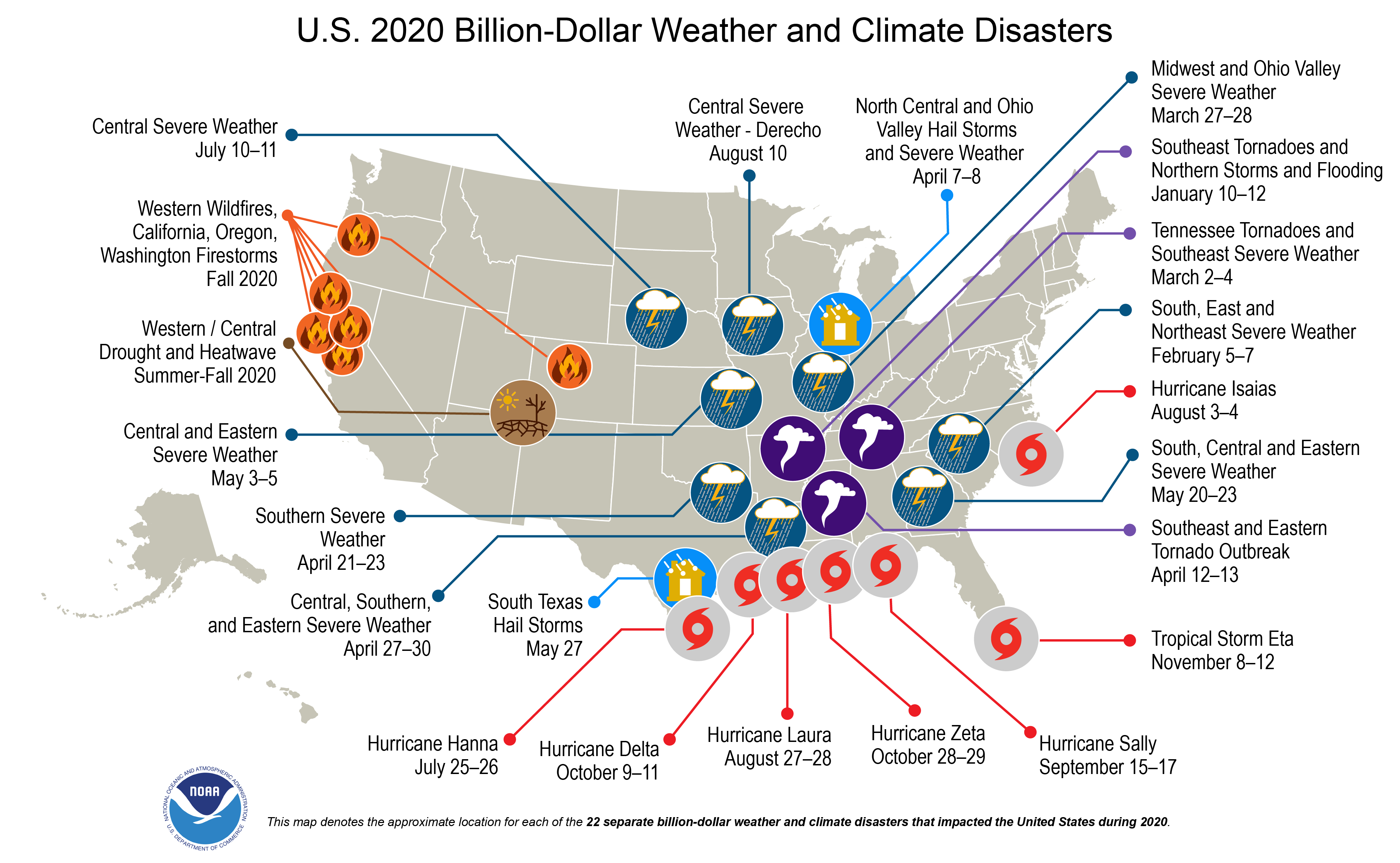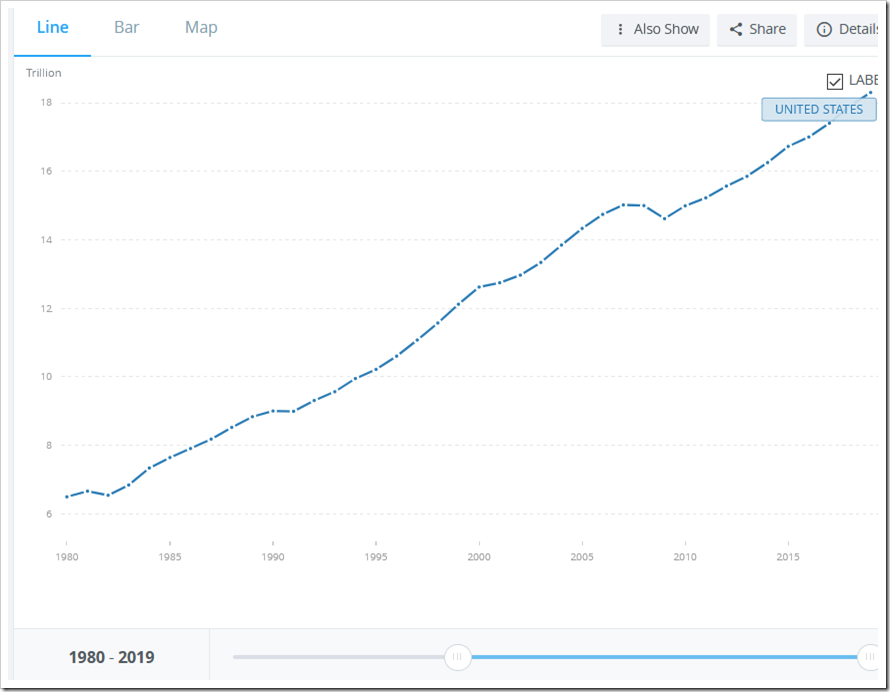NOAA’s Climate Disaster Claims Are A Sham
By Paul Homewood
Stewgreen has tracked down the NOAA climate disaster website, which the BBC used for their video yesterday.
https://www.ncdc.noaa.gov/billions/
It is evident just by looking at it that the whole thing is totally fraudulent. First a look at the map:

When a hurricane hits a populated stretch of coast, which is almost invariably, it is inevitable losses will be big. But while last year was a busy year for hurricanes, we do know that the frequency of US hurricanes has not been unusual in the last decade, and if anything the long term trend is down. (Though it is worth noting that the 1980s and 90s were below average, making the choice of 1980 as a start date statistically inappropriate):
https://www.aoml.noaa.gov/hrd/hurdat/All_U.S._Hurricanes.html
However, the vast majority of these wrongly named “climate” disasters are either tornadoes, hailstorms or severe weather (which are almost all thunderstorm/tornado outbreaks).
Again, we know that tornado activity has declined significantly since the 1970s. But we are expected to believe that tornadoes and thunderstorms nowadays are far more catastrophic than in the past.
The answer to this riddle lies in how NOAA determine what a billion dollar disaster is. The key is this sentence:
The U.S. has sustained 285 weather and climate disasters since 1980 where overall damages/costs reached or exceeded $1 billion (including CPI adjustment to 2020).
So, they rightly allow for inflation, but is that enough?
The simple truth is that Americans have much more “stuff” than they did back in the 1980. Bigger houses, more cars, latest technological gadgetry, expensive furniture and clothes, and all the rest of it.
If a house burns down, the cost of rebuilding it and replacing contents will have increased by much more than inflation since 1980.
The same goes for local infrastructure and services.
The best way to monitor this is by looking at GDP, not CPI, which says that $1 in 1980 is now worth $3.32:
GDP however has risen from $2857bn in 1980, to $21433bn in 2019, which is 7.3 times as big.
https://countryeconomy.com/gdp/usa
We can see the impact of rising wealth better by looking at constant GDP, which has been adjusted for CPI:
This index of GDP, which measures real growth, has jumped from $6.5 trillion in 1980 to $18.3 trillion, nearly trebling.
So when a billion dollar disaster in 1980 is equivalent to a $3 billion one now.
We can also look at house price trends. The chart below is deflated using CPI, so again reflects real prices, rather than monetary ones. It has risen from 81.78 to 134.88, a factor of 1.65:
https://fred.stlouisfed.org/series/QUSR628BIS
Out of the twenty two billion dollar disasters last year, supposedly a record, nine were below $2 billion. There is absolutely no doubt at all that if they had occurred in 1980, none of them would have cost more than a billion.
Hurricanes
We can actually make a direct comparison between the 1985 hurricane season and last year; both had six hurricanes.
In 1985, only three of the hurricanes enter the list, with a total cost of $9bn. In comparison, all six of last year’s appear, plus Tropical Storm Eta, with a combined cost of $40.1. The average cost per hurricane has risen from $3bn to $5.7bn. This is strong evidence that it is increasing wealth which is driving the rising cost of disasters, not the impact of climate.
Comments are closed.








Paul, have you seen the graph that the NOAA published earlier this year showing rising atmospheric CO2 levels with of course the skewed Y Axis? If not please do so, they have just published a new one with space for data from 2021 to 2022. Bearing in mind the world wide lock down from March 2020 with anthropogenic CO2 emissions drastically reduced it would be expected that the amount of CO2 would have levelled off, at worst or declined at best. There is no change in the amount of CO2 entering the atmosphere whatsoever. I would like yo copy and paste it but cannot do so.
I’m no expert on this but it seems to me that the contributions to atmospheric CO2 include man-made, natural such as from volcanic eruptions and the biosphere and outgassing from the mass of CO2 dissolved in the oceans. The biosphere seasonal effect produces the saw-tooth pattern. The absence of any other fluctuations suggests that man-made emissions are too small to show up. The steady rise must therefore be due to the long term gradual ocean warming that corresponds to long term sea level rise of about 3 mm per year. It might be due to warming up from the Little Ice Age. The solubility of the gas decreases with rising water temperature. (Henry’s Law).
Andrew.. “There is no change in the amount of CO2 entering the atmosphere whatsoever.”
Last year the amount of world-wide CO2 emissions was about 40 billion metric tons. It has increased every year…and will keep on doing so even as (and if) we were able to reach zero emissions by 2050. That’s the problem our leaders don’t want to face. Right now the global industrial capture and geological storage of CO2 under pressure is only 40 MILLION tons a year. it would take about 1000 years to store last years emissions. Waste of time and lots of money.
Also, more people are building in places they would not have in the past.
… and should not in the present. Much of the UK’s flooding problem stems either from building on flood plains or from bad management of watercourses or flood “prevention” (properly “diversion”) measures resulting from the other two.
There is, as Paul has pointed out more than once, no statistical evidence for increased rainfall in recent decades. And climate change policies are not going to reduce rainfall but are going to make it more difficult and more expensive to deal with floods (and other severe weather events) when they happen.
It is clear that NOAA, the Met Office, the BBC The Guardian and countless other organisations are determined to convince the public that we are in the grip of a terrible climate disaster. Why is this?
Some say that it is a left wing socialist scheme to redistribute global wealth. The UN have admitted as much, but then, others claim that it is a UN plan to achieve global governance and the taxation of countries. It is clear that the super rich see climate change as a 50 trillion investment opportunity. As a business model, what could be better than having governments all over the world force through legislation to change most aspects of life to follow a predetermined pattern? That pattern specifies the technology that must be used, the energy that must be used and the rules.
The same business plan recognises that legislation is a blunt tool so government subsidies are to be used to persuade people to change and stimulate demand. Subsidy harvesting is a lucrative industry.
The academic sector is central to providing the justification for this revolution. Funding buys scientific evidence and the lack of funding leaves scientific evidence largely undiscovered. Governments can choose which they want, and they do.
So, is this a conspiracy? What is in it for the Met office, apart from massive funding and billions spent on computers every couple of years? What is in it for the BBC? We have lots of senior scientists who must see that climate models are a joke, energy policy is lunacy and Climate Change has become a scam. Why are they silent?
Christopher Booker called it Group Think. It is probably beyond that now. What do people here think?
Money for the few very rich is by far the most important aspect. Capitalism is criticized for allowing too much wealth being in the hands of too few people. I criticize communism for allowing too much wealth to be in the hands of even fewer people. Money is power. Power corrupts etc.
A snowball effect maybe? I.e. when you have made some money, you want to make more, then even more, and so on ad infinitum, but losing any sense of reality in the process.
Excellent work Paul! Not only is wealth increasing, but also very importantly, population has increased tremendously in many vulnerable coastal areas since 1980. For example, the population in Florida increased from 9.7 million in 1980 to 21.5 million in 2019, more than double!
Good point about Florida.
More generally:
Population USA:
1980 = 229,476,000
2021 = 332,915,000
I like to think of the things that the news shows in disasters, destroyed houses and cars.
US Median house price Index
1940: $2,938
1950: $7,354
1960: $11,900
1970: $17,000
1980: $47,200
1990: $79,100
2000: $119,600
2020: $346,800
Nearly tripled in last 20 years.
Cars VW Golf in UK cost about £5.5K in 1980 current price is minimum £25K, 5 fold increase but not as impressive property
And when the power goes out – in Texas – the residents on smart meters have seen huge bills (in the thousands) because – smart meters.
I do hope this is brought home to UK smart meter owners.
Smart Consumer Accessible Metering Devices. (you work it out). 🙂
Paul, the credit is wrong this time
I was actually @Duker replying to me who provided the link
typo : It was
Paul did a post on the BBC referring to NOAA disaster database that made me curious about this ‘new bright shiny thing’
It looks like the median house price in the USA, inflation adjusted, rose from around $175K in 1980 to $275K in 2020. That quite a hike and would certainly bump up the cost of an average disaster.
https://dqydj.com/historical-home-prices/
Additionally the US population has grown from around 230mn in 1980 to around 330mn in 2020.
https://www.macrotrends.net/countries/USA/united-states/population
Presumably these people will live in houses etc. so the housing stock will have grown, no surprise there.
I would guess that, since the amount of land hasn’t increased, all this means the USA has areas of higher house density and more expensive houses as well. As Paul has pointed out, also, people have become richer in acquired goods terms.
All this means that for each disaster it is likely that more houses, with higher values, will be damaged and more goods will be lost, all adding to higher claims. Its not surprising that there are more $1bn claims but the monetary value is in no way a true reflection of a worsening disaster situation.
Thank you for this very detailed and useful analysis.
Official data suggests that CO2 content increased since the preindustrial era from 275 to 400. Is there a reliable piece of evidence that ALL of that is due to anthropogenic activity ( plus as a result of a positive feedback in the natural and anthropogenic processes causing oceans to warm up and therefore release of the dissolved CO2)?